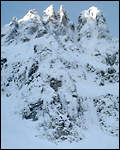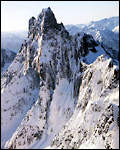
An Excerpt from
James Martin's Book
"North Cascades Crest"
CHECK OUT
Martin Photography
Chamonix: To Climb
Patagonia's
Changing Face
© 1999
MountainZone.com.
All Rights Reserved.

The Triplets in Winter
Excerpted from North Cascades Crest, Chapter Six
 The Triplets in Winter [click to zoom] |
In the warmth of the living room, our plans had the ring of sweet reason. Jim Nelson, one of the region's best winter climbers, proposed an unclimbed line on the north wall of Johannesburg Mountain. If that ice climb proved too ambitious, we would scamper up a short gully on the neighboring Triplets.
| "As he stepped around a bulge, he called down: 'Watch me. I'm terrified'..." |
As our car nosed up the snow-covered Cascade River Road, conditions seemed perfect: high clouds, cool temperatures, old avalanche debris at the base of the steep gullies called couloirs. Our intended route came into view after a mile of snowshoeing. The early-season ice hadn't yet filled the couloir on Johannesburg as we had hoped it would, so instead we trudged up to Cascade Pass, intent on bagging the Triplets. We dug a snow trench for shelter against the building wind, which soon shooed us into our bivouac sacks. We carried no tent; we knew that going fast meant going light. But I regretted not bringing one, as spindrift sneaked into my bivy sack and my sleeping bag. At least I had brought a sleeping bag. Jim had opted for only a half bag zipped to a down jacket.
A cloudless sky greeted us in the morning. After the usual winter struggle with clothing and breakfast, we slowly hiked to the Triplets.
 Mt. Slesse [click to zoom] |
Almost immediately, thin ice slowed us. I still expected, however, to summit near midday. The fact that we had left our headlamps and bivy gear in camp didn't trouble me. We were light and fast.
The ice disappeared entirely, leaving a leftward traverse across bare rock toward the narrowing gully. To my relief Jim gathered the gear and led. His crampon points ground against stone as he placed them on tiny edges. Compact rock rejected pitons. After much fussing, he hammered in two thin pitons thirty feet up, which we recognized as psychological protection. They likely wouldn't hold a fall.
As he stepped around a bulge, he called down: "Watch me. I'm terrified." This was not welcome news. Jim normally relished climbs that drove me to consider confining my thrill-seeking to chess matches and wedding photography. Any bit of climbing that slowed him at all would be desperate business for me.
|
"We hurried to the car with the wind pummeling our backs. The North Cascades had spit us out..." |
On closer inspection the sheet of vertical ice became a cluster of detached icicles. To ascend, one foot clawed the hanging ice while the other sought purchase on wet rock between the icicles. It was all coming back to me. The tug on the rope became a pull as Jim winched me up.
Midday was already a memory, but the route eased back and our optimism returned. The gully necked down to six feet across and zigzagged up, obscuring the route, but the loose snow allowed us to create steps and move quickly. With luck, we could still get up and off before dark. Growing urgency propelled us upward. As we ascended, the snow deepened and softened, slowing us and reducing security. We surmounted a couple difficult steps before arriving at the funnel of a small snow bowl. Jim laboriously packed the powder into steps and swam to the top of the gully as evening alpenglow tinted the surrounding peaks. It was late. We were in trouble.
| "The worst was over, but the moonless night yielded little light. We picked our way down unroped, unable to see our feet. The slope steepened..." |
The worst was over, but the moonless night yielded little light. We picked our way down unroped, unable to see our feet. The slope steepened. A section that seemed trivial in daylight required perfect placements. The terrain dipped to 60 degrees. Crampon points and axes bounced off rock behind thin ice. Concentration battled with haste and fatigue. I forced myself to focus all attention on each placement. The world became very small and compelling.
I found Jim inspecting every square inch of a ledge at the base of this section. We were atop a fifty-foot cliff, though just below I could see a gentle slope dipping to Cascade Pass . The expanse of snow reflected starlight, and the glow of nearby towns silhouetted the peaks. No wind interrupted a perfect silence.
"No anchors," Jim announced.
While I would have preferred a miracle, I resigned myself to a night of doing jumping jacks to stay warm. We had survived. We would get off the ledge at first light, with all body parts intact.
"I've got something," Jim said.
He had found a hole in the rock by fumbling blindly. He threaded a sling through the hole. After a minute of aggressive testing, we rappelled down to our snowshoes. An hour later we found our snow trench and wiggled into frozen bivouac sacks.
Next morning the wind wailed across the pass, blowing snow hundreds of feet into space. We hurried to the car with the wind pummeling our backs. The North Cascades had spit us out.
— James Martin, MountainZone.com Correspondent
[MountainZone.com Home]